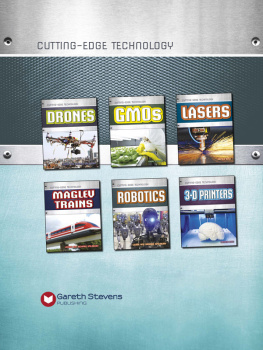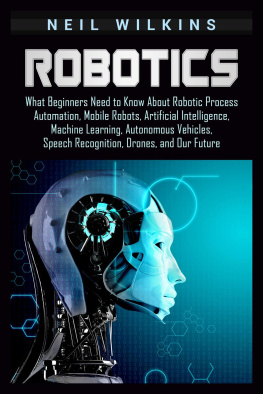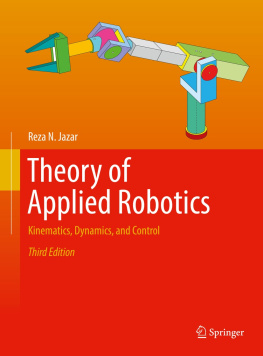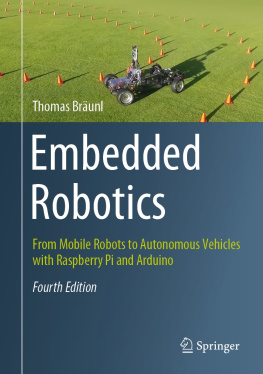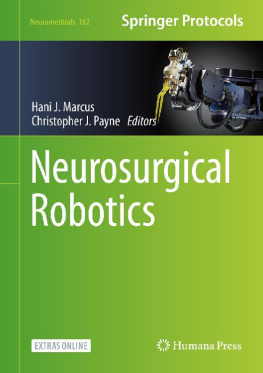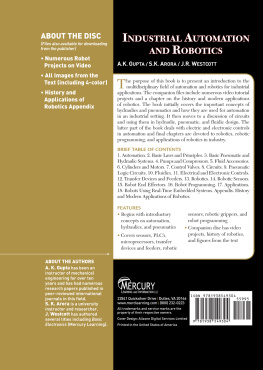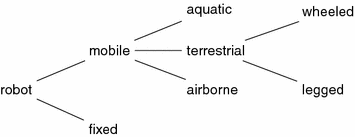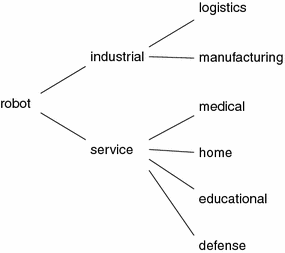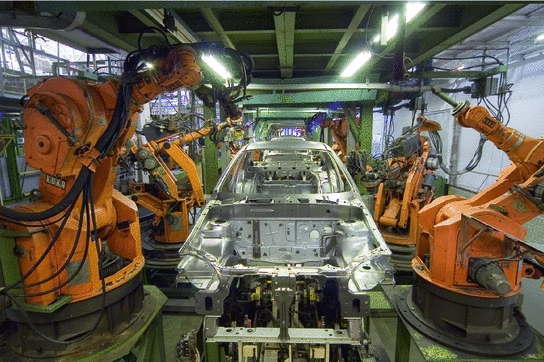1. Robots and Their Applications
Although everyone seems to know what a robot is, it is hard to give a precise definition. The Oxford English Dictionary gives the following definition: A machine capable of carrying out a complex series of actions automatically, especially one programmable by a computer. This definition includes some interesting elements:
Carrying out actions automatically. This is a key element in robotics, but also in many other simpler machines called automata. The difference between a robot and a simple automaton like a dishwasher is in the definition of what a complex series of actions is. Is washing clothes composed of a complex series of actions or not? Is flying a plane on autopilot a complex action? Is cooking bread complex? For all these tasks there are machines that are at the boundary between automata and robots.
Programmable by a computer is another key element of a robot, because some automata are programmed mechanically and are not very flexible. On the other hand computers are found everywhere, so it is hard to use this criterion to distinguish a robot from another machine.
A crucial element of robots that is not mentioned explicitly in the definition is the use of sensors. Most automata do not have sensors and cannot adapt their actions to their environment. Sensors are what enable a robot to carry out sanscomplex tasks.
In Sects. gives a detailed overview of the contents of the book.
1.1 Classification of Robots
Robots can be classified according to the environment in which they operate (Fig. ). The most common distinction is between fixed and mobile robots. These two types of robots have very different working environments and therefore require very different capabilities. Fixed robots are mostly industrial robotic manipulators that work in well defined environments adapted for robots. Industrial robots perform specific repetitive tasks such soldering or painting parts in car manufacturing plants. With the improvement of sensors and devices for human-robot interaction, robotic manipulators are increasingly used in less controlled environment such as high-precision surgery.
Fig. 1.1
Classification of robots by environment and mechanism of interaction
By contrast, mobile robots are expected to move around and perform tasks in large, ill-defined and uncertain environments that are not designed specifically for robots. They need to deal with situations that are not precisely known in advance and that change over time. Such environments can include unpredictable entities like humans and animals. Examples of mobile robots are robotic vacuum cleaners and self-driving cars.
There is no clear dividing line between the tasks carried out by fixed robots and mobile robotshumans may interact with industrial robots and mobile robots can be constrained to move on tracksbut it is convenient to consider the two classes as fundamentally different. In particular, fixed robots are attached to a stable mount on the ground, so they can compute their position based on their internal state, while mobile robots need to rely on their perception of the environment in order to compute their location.
There are three main environments for mobile robots that require significantly different design principles because they differ in the mechanism of motion: aquatic (underwater exploration), terrestrial (cars) and aerial (drones). Again, the classification is not strict, for example, there are amphibious robots that move in both water and on the ground. Robots for these three environments can be further divided into subclasses: terrestrial robots can have legs or wheels or tracks, and aerial robots can be lighter-than-air balloons or heavier-than-air aircraft, which are in turn divided into fixed-wing and rotary-wing (helicopters).
Fig. 1.2
Classification of robots by application field
Robots can be classified by intended application field and the tasks they perform (Fig. ). We mentioned industrial robots which work in well-defined environments on production tasks. The first robots were industrial robots because the well-defined environment simplified their design. Service robots, on the other hand, assist humans in their tasks. These include chores at home like vacuum clears, transportation like self-driving cars, and defense applications such as reconnaissance drones. Medicine, too, has seen increasing use of robots in surgery, rehabilitation and training. These are recent applications that require improved sensors and a closer interaction with the user.
1.2 Industrial Robots
The first robots were industrial robots which replaced human workers performing simple repetitive tasks. Factory assembly lines can operate without the presence of humans, in a well-defined environment where the robot has to perform tasks in a specified order, acting on objects precisely placed in front of it (Fig. ).
Fig. 1.3
Robots on an assembly line in a car factory.
Source https://commons.wikimedia.org/wiki/File:AKUKA_Industrial_Robots_IR.jpg by Mixabest (Own work). CC BY-SA 3.0 ( http://creativecommons.org/licenses/by-sa/3.0 ) or GFDL ( http://www.gnu.org/copyleft/fdl.html ), via Wikimedia Commons
One could argue that these are really automata and not robots. However, todays automata often rely on sensors to the extent that they can be considered as robots. However, their design is simplified because they work in a customized environment which humans are not allowed to access while the robot is working.
However, todays robots need more flexibility, for example, the ability to manipulate objects in different orientations or to recognize different objects that need to be packaged in the right order. The robot can be required to transport goods to and from warehouses. This brings additional autonomy, but the basic characteristic remains: the environment is more-or-less constrained and can be adapted to the robot.
Additional flexibility is required when industrial robots interact with humans and this introduces strong safety requirements, both for robotic arms and for mobile robots. In particular, the speed of the robot must be reduced and the mechanical design must ensure that moving parts are not a danger to the user. The advantage of humans working with robots is that each can perform what they do best: the robots perform repetitive or dangerous tasks, while humans perform more complex steps and define the overall tasks of the robot, since they are quick to recognize errors and opportunities for optimization.
1.3 Autonomous Mobile Robots
Many mobile robots are remotely controlled, performing tasks such as pipe inspection, aerial photography and bomb disposal that rely on an operator controlling the device. These robots are not autonomous; they use their sensors to give their operator remote access to dangerous, distant or inaccessible places. Some of them can be semi-autonomous, performing subtasks automatically. The autopilot of a drone stabilizes the flight while the human chooses the flight path. A robot in a pipe can control its movement inside the pipe while the human searches for defects that need to be repaired. Fully autonomous mobile robots do not rely on an operator, but instead they make decisions on their own and perform tasks, such as transporting material while navigating in uncertain terrain (walls and doors within buildings, intersections on streets) and in a constantly changing environment (people walking around, cars moving on the streets).


